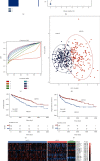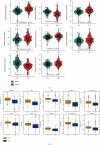Deciphering the Role of Melatonin-Related Signatures in Tumor Immunity and the Prognosis of Clear Cell Renal Cell Carcinoma
- PMID: 36825082
- PMCID: PMC9943605
- DOI: 10.1155/2023/3077091
Deciphering the Role of Melatonin-Related Signatures in Tumor Immunity and the Prognosis of Clear Cell Renal Cell Carcinoma
Abstract
Methods: Adopting multiomics data from TCGA and other public datasets, we analysed the expression, mutation, and prognostic evaluation in multiple cancers. ccRCC patients were categorized into two subgroups by an unsupervised cluster algorithm: melatonin-pattern cancer subtype 1 (MPCS1) and subtype 2 (MPCS2). We then explored the immune microenvironment, immune therapy response, and tumor metabolic pathways between the two subtypes. The clinical characteristics, genomic mutation landscape, and molecular inhibitor response were further investigated. Finally, a melatonin regulator-related prognostic model was constructed to predict patient prognosis in ccRCC.
Results: We found that melatonin regulators were dysregulated depending on distinct cancer types, which were associated with genomic variation. The two subtypes indicated different clinical characteristics and biological processes in ccRCC. MPCS2, an aggressive subtype, led an advanced clinical stage and poorer survival of ccRCC patients. The activated oncogenic signaling pathway and metabolic signatures were responsible for cancer progression in the MPCS2 subtype. The MPCS2 subgroup suggested a higher tumor mutational burden and immune dysfunction state, resulting in a lower response to immunotherapy. The copy number variations of MPCS2 were significantly more frequent than those of MPCS1. In addition, the two subgroups exhibited distinct drug responsiveness, with MPCS2 being less responsive to multiple drugs. Finally, we established a subtype biomarker-based prognostic risk model that exhibited satisfactory performance in ccRCC patients.
Conclusion: Melatonin regulator-related features could remodel functional pathways and the tumor immune microenvironment through genomic mutations and pathway regulation. Melatonin regulator-associated molecular subtypes enhance the understanding of the molecular characteristics of renal cancer and can guide clinical treatment. Activating the melatonergic system axis may improve the effect of immunotherapy for ccRCC.
Copyright © 2023 Aimin Jiang et al.
Conflict of interest statement
The authors report that there are no competing interests to declare.
Figures











References
MeSH terms
Substances
LinkOut - more resources
Full Text Sources
Medical

